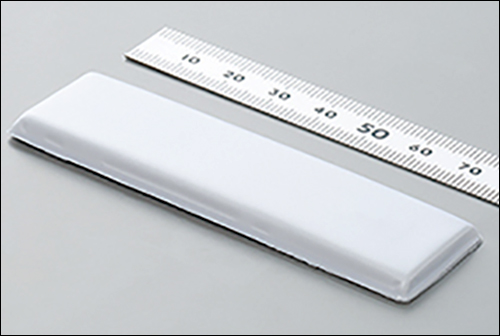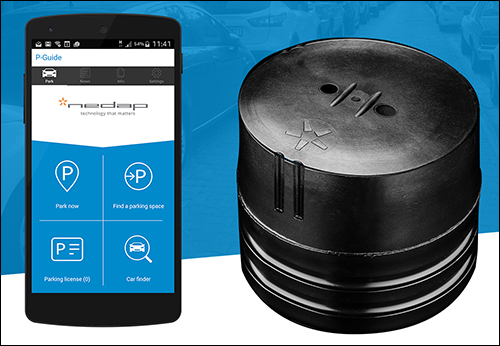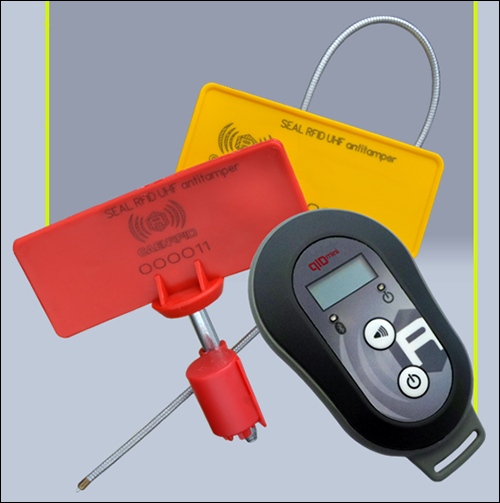The following are news announcements made during the past week by the following organizations:
Murata;
Harland Simon, GS1 Ireland;
Nedap;
SATO;
Identiv, Zwipe; and
CAEN RFID.
Murata Intros RAIN RFID Tag for Use on Metal
Murata Manufacturing has announced its latest RAIN RFID tag for use on metal: the p/n LXFLANMXMG-003 tag, production of which is slated to begin this year. Placing RAIN RFID tags on metal can be challenging, the company explains, because metal surfaces reflect the signal emitted from a reader and interfere with communication between the device and RFID tags. The LXFLANMXMG-003 is designed to use an item’s metal surface as part of its antenna, making the object itself part of the RAIN RFID tag.
Murata developed the LXFLANMXMG-003 tag specifically for industries in which metal assets need to be tracked. According to the company, the tag is suitable for tracking such items as construction equipment, IT assets, cage cars or logistics containers, as well as other metal parts used in the manufacturing industry, and can be used to identify an item’s location. The tag enables the application of RAIN RFID on tools, containers and bins that are often difficult to identify visually, may be hard to track and relocate if they end up missing, and may be expensive to replace.

Impinj‘s Monza R6-P tag chip can be combined with Murata’s design to boost tag-read performance. The product meets the IP-68 waterproofing standards, allowing outdoor use without degraded performance. The Monza R6-P chip contains 96 bits of Electronic Product Code (EPC) memory and 64 bits of user memory, allowing users to encode additional information to the tag, such as internal identification numbers.
“The industrial sector has been waiting for a tag that is capable of high performance in tough environments,” said Carl Brasek, Impinj’s senior director of product management for silicon products, in a prepared statement. “The Murata LXFLANMXMG-003 on-metal tag with the Impinj Monza R6-P chip brings reliable RAIN RFID functionality and a new world of data and operational insights to this market.”
Harland Simon, GS1 Ireland Partner on Asset-Tracking, Inventory-Management Solutions
Harland Simon, a provider of RFID-based solutions for the health-care sector, has announced its participation in GS1 Ireland‘s Solution Provider Program. As partners, GS1 Ireland and Harland Simon will work together to support organizations in using GS1 identifiers, bar codes and RFID technology to provide solutions for real-time location tracking and inventory management.
Harland Simon helps health-care providers improve their utilization and tracking of medical devices and other assets in order to boost patient safety, through the use of GS1-compliant labels incorporating a passive RFID tag. Individual devices and assets can be bar-code-scanned in line of sight, while multiple assets can be captured quickly via mobile or fixed RFID readers.
Inventory audits can be carried out in less time than with traditional asset tags, the company reports. Harland Simon’s RFiD Discovery asset-tracking software is designed to reduce the amount of time nurses and other clinical personnel spend searching for equipment. The software assists medical engineers in identifying devices in need of maintenance and repair, thereby increasing patient safety.
The RFiD Discovery system is currently in use at more than 20 trusts throughout the United Kingdom, including Cambridge University Hospitals NHS Foundation Trust (CUH), the first NHS trust in that country to implement GS1-compliant asset labelling for its 37,500 medical devices. Its use has provided multiple benefits, the firm notes, including better inventory management through quicker and more frequent auditing. For example, a test audit on six wards previously took two weeks to complete with up to 35 percent of devices unaccounted for, whereas the same process now takes just 10 to 15 minutes with more than 90 percent of inventory detected. The system has also improved the process of risk management by minimizing the circulation of potentially dangerous, unsuitable or unmaintained equipment.
In addition, CUH is ready for Britain’s Scan4Safety initiative, under which equipment can be scanned against a patient’s wristband to identify the exact device used for that individual. Since the implementation at CUH, Harland Simon has helped other hospitals to deploy GS1-compliant asset-labeling systems as well, including London’s Kingston Hospital, East Kent Hospitals and Heart of England NHS Trust. The company has also provided labels for St Vincent’s Hospital in Dublin, and advised on GS1 labelling techniques for its early-stage studies.
“GS1 Ireland’s primary objective is to support health-care providers in their goal to deliver patient safety while also achieving high levels of efficiency and cost reduction through the use of GS1 standards,” said Mike Byrne, GS1 Ireland’s chief executive officer, in a prepared statement. “Partnering with companies like Harland Simon helps us achieve this goal for the benefit of our members.”
“We have supported the use of GS1 standards for medical device labelling in the UK for a number of years,” added Andy James, Harland Simon’s director of health-care solutions, in the prepared statement, “and are excited about the opportunity to help hospitals in Ireland on their journey to benefit from GS1-compliant asset labelling.”
Nedap Launches Smart-Parking Sensor Platform
Nedap, a provider of parking-detection technologies, has launched a new line of smart parking products, including a smart parking sensor, a parking-guidance app and a gateway. The company’s new platform, known as SENSIT, is designed to optimize parking guidance and traffic flows in city centers and retail environments, resulting in reduced congestion and emissions, safer streets, and a more attractive city for visitors and retailers.
Nedap’s SENSIT IR Flush Mount sensor combines infrared and magnetic field-detection technologies. It can be installed completely recessed into a road’s surface, making it resistant to snow plows and preventing tripping hazards. The sensor detects the occupancy of individual parking spaces in real time.

“We are very proud to launch this new generation of SENSIT sensors,” said Edwin Siemerink, Nedap’s SENSIT proposition manager, in a prepared statement. “Our products have proven to be the reliable and durable parking detection solution for years in applications all over the world. With the addition of the SENSIT IR Flush Mount, Nedap responds to the growing demand for highly accurate sensors that are mounted fully flush into the road surface.”
Nedap’s SENSIT P-Guide App, available for both iOS and Android smartphones, enables cities, municipalities and companies to provide motorists with real-time parking information. The app can be fully customized to fit a city’s marketing needs, and helps motorists locate and navigate to available parking spaces, both on- and off-street. Recently, the P-Guide app was introduced in the Dutch city of Zoetermeer.
Finally, Nedap’s SENSIT Gateway, an interface between the wireless SENSIT network and the interface software, offers 3G, Ethernet and GPRS communication. The design of the interface software is completely map-oriented and, according to the company, enables the configuration of any smart parking application.
SATO to Unveil Intelligent Label-Printing Technologies
SATO, a provider of automatic-identification solutions, has announced that it will showcase its intelligent label-printing solutions at Manhattan Exchange 2017, a conference that will explore the impact of multi-channel operations in business-to-business (B2B) and business-to-channel (B2C) selling environments. At the event, which will take place in London on Oct. 3-4, SATO will demonstrate how its track-and-trace label-printing systems allow customers with complex global supply chains to empower their workforce and streamline operations.
“One of the big questions asked at the event will be how we maximize efficiency to provide the ultimate customer experience,” said Eckhard Wernich, SATO Europe’s business-development manager, in a prepared statement. “We’ll be demonstrating how less hardware and more intelligence is the answer. For example, one SATO Application Enabled Printing (AEP) solution can control multiple SATO NX Series thermal label printing devices and data streams. Imagine the ability to receive, modify, communicate and write back mission critical data within your IT process, without the risk of human error. It’s possible with AEP.”
SATO will outline how its solutions can be integrated into customers’ enterprises. Delegates will be able to learn more about the recent integration of SATO’s technology into Manhattan Associates‘ Warehouse Management for Open Systems (WMOS) with support from CYBRA‘s MarkMagic PI (Platform Independent) edition.
Identiv, Zwipe Team Up to Provide Biometric Access
Identiv has announced that it has partnered with biometric technology company Zwipe for access control card formatting services. Identiv’s U.S.-based card service bureau is programming the RFID chips in Zwipe’s biometric credential line, providing all physical access control system formats from Identiv’s portfolio.
In order to encode its biometric cards in a variety of formats, Zwipe connected with Identiv. Through this collaboration, Zwipe’s customers can order its access-control products pre-formatted with 125 KHz and 13.56 MHz smart card formatting schemes, enabling integration with end-customer systems without the need for additional card-formatting services by the integrator.
“Identiv is seeing strong growth in the interest for biometric-enabled access-control solutions,” said Stephane Ardiley, Identiv’s director of product management, in a prepared statement. “Zwipe’s credential products are very user friendly and offer a fast, efficient way for customers to upgrade to a biometric security level in their access control installations without the need to change their readers and back-end system. We see a good opportunity for Identiv by supplying formatting services for Zwipe cards, which we believe meets a strong, growing need in the marketplace.”
Zwipe’s biometric credentials are provided as credit card-sized cards with embedded biometric sensors for user enrollment and identity verification. After authentication is made via fingerprinting, the card’s RFID interface is enabled, allowing it to behave like a typical access-control credential.
“We are very excited to work with Identiv, as it allows us to address a large segment of customers for the first time—not just in the U.S., but across the world — thanks to the company’s expansive customer network,” said Einar Boije, Zwipe’s senior VP of access control, in the prepared statement. “With Identiv’s capacity, we can now provide formatting services alongside our access control product lines, making it that much easier to integrate and deploy the world’s smallest biometric reader.”
CAEN RFID Releases Two New Readers
CAEN RFID has announced two new mobile RFID readers. The company’s qIDmini and qID readers, when used in combination with a smartphone or tablet, enable users to read a seal’s Electronic Product Code (EPC) and tamper status.
The qIDmini (model R1170I), a RAIN RFID handheld reader in the company’s easy2read product family, is compliant with the ISO 18000-6C/EPC Class 1 Gen 2 UHF RFID standards. The qIDmini has an integrated antenna suitable for short- to medium-range applications. Due to its Bluetooth communication interface, the firm reports, the device provides a UHF RFID add-on for any Bluetooth-enabled host, such as a PC, a smartphone, a PDA or a tablet. The reader is compatible with Microsoft Windows XP/7 and Windows CE/Mobile, Android, and Appile iPhone and iPad operating systems. The HID version supports native keyboard emulation, allowing it to interact directly with legacy applications, office automation software or other generic solutions requiring manual input.

The qIDminiNF version is specifically designed to optimize reading performance with near-field miniaturized tags, like Murata’s Magicstrap and Hitachi’s USPT. The near-field antenna of the qIDminiNF reader permits users to read small tags, even those embedded in small parts like watches, jewels or mechanic parts. According to the company, the combination of the miniaturized near-field tags and the qIDminiNF reader allows users to retrieve the serial numbers of small objects and to check the originality of parts.
The reader can operate in Batch Mode, enabling it to store EPC codes into internal memory when communication links (USB or Bluetooth) are not available. Designed for mobile operators in indoor or outdoor areas, the qIDmini is suitable for use in in-store inventory management, field sales mobility, and service and maintenance applications.
The qID (model R1240IE, R1240IU) is a wearable RAIN RFID reader, also of the easy2read family, with an integrated antenna for medium- to long-range applications. It is compliant with the ISO 18000-6C/EPC Class 1 Gen 2 RFID standards. The reader hosts an internal rechargeable battery and can operate in wired mode (using a USB cable) or in wireless mode (through the Bluetooth interface).
Thanks to the Bluetooth communication interface, the qID provides an add-on for any Bluetooth-enabled host, such as a PC, a smartphone, a PDA or a tablet for UHF RFID readings. The reader is compatible with Windows XP/7/8/10, Windows CE/Mobile, Android and iOS operating systems, and can also operate in Batch Mode, allowing it to store up to 500,000 EPCs into internal memory when communication links (USB or Bluetooth) are not available.
The qID can work autonomously thanks to its internal scripting engine; a user can upload a script to be executed if the trigger button is pressed. The scripting language permits users to access all Gen 2 commands, and to drive an optional bar-code scanner, LEDs and internal memory. An optional 1D-2D bar-code imager enables the qID to read most bar-code standards. Designed for mobile operators, the qID is suitable for inventory management, field sales mobility, service and maintenance applications.

